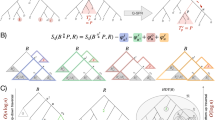Abstract
We study the computational complexity and approximation of several problems arising in the comparison of evolutionary trees. It is shown that the maximum agreement subtree (MAST) problem for three trees with unbounded degree cannot be approximated within ratio \(2^{\log ^\delta n}\)in polynomial time for any δ < 1, unless NP \(\subseteq\)DTIME[2polylog n], and MAST with edge contractions for two binary trees is NP-hard. This answers two open questions posed in [1]. For the maximum refinement subtree (MRST) problem involving two trees, we show that it is polynomialtime solvable when both trees have bounded degree and is NP-hard when one of the trees can have an arbitrary degree. Finally, we consider the problem of optimally transforming a tree into another by transferring subtrees around. It is shown that computing the subtree-transfer distance is NP-hard and an approximation algorithm with performance ratio 3 is given.
Supported in part by NSERC Research Grant OGP0046613 and NSERC/MRC C-GAT Grant GO-12278.
Supported in part by NSERC Research Grant OGP0046373.
Preview
Unable to display preview. Download preview PDF.
Similar content being viewed by others
References
A. Amir and D. Keselman, Maximum agreement subtree in a set of evolutionary trees — metrics and efficient algorithms, IEEE FOCS'94, 1994.
S. Arora, C. Lund, R. Motwani, M. Sudan, and M. Szegedy, Proof verification and hardness of approximation problems, Proc. 33rd IEEE Symp. Found. Comp. Sci., 14–23, 1992.
G. Estabrook, C. Johnson and F. McMorris, A mathematical foundation for the analysis of cladistic character compatibility, Math. Biosci. 29, 181–187, 1976.
M. Farach and M. Thorup, Fast comparison of evolutionary trees, in Proc. 5ith Annual ACM-SIAM Symposium on Discrete Algorithms, 1994.
M. Farach and M. Thorup, Optimal evolutionary tree comparison by sparse dynamic programming, IEEE FOCS'94, 1994.
C. Finden and A. Gordon, Obtaining common pruned trees, Journal of Classification 2, 255–276, 1985.
M. R. Garey and D. S. Johnson, Computers and Intractability: A Guide to the Theory of NP-Completeness, W. H. Freeman, 1979.
D. Gusfield, Efficient algorithms for inferring evolutionary trees, Networks 21, 19–28, 1991.
J. Hein, Reconstructing evolution of sequences subject to recombination using parsimony, Math. Biosci. 98, 185–200, 1990
J. Hein, A heuristic method to reconstruct the history of sequences subject to recombination, Journal Molecular Evolution 36, 396–405, 1993.
T. Jiang and M. Li, On the approximation of shortest common supersequences and longest common subsequences, to appear in SIAM J. Comput.; also presented at ICALP'94.
T. Jiang, L. Wang and K. Zhang, Alignment of trees — an alternative to tree edit, Theoretical Computer Science 143-1, 137–148, 1995.
V. Kann, Maximum bounded 3-dimensional matching is MAX SNP-complete, Information Processing Letters 37, 27–35, 1991.
J. Kececioglu and D. Gusfield, Reconstructing a history of recombinations from a set of sequences, Proc. 5th ACM-SIAM SODA, 1994.
C.H. Papadimitriou and M. Yannakakis, Optimization, Approximation, and complexity classes, Journal of Computer and System Sciences 43, 425–440, 1991.
M. Steel and T. Warnow, Kaikoura tree theorems: computing the maximum agreement subtree, Information Processing Letters 48, 77–82, 1993.
T. Warnow, Tree compatibility and inferring evolutionary history, J. of Algorithms 16, 388–407, 1994.
T. Warnow, Private communication, 1994.
K. Zhang and D. Shasha, Simple fast algorithms for the editing distance between trees and related problems, SIAM J. Comput. 18, 1245–1262, 1989.
Author information
Authors and Affiliations
Editor information
Rights and permissions
Copyright information
© 1995 Springer-Verlag Berlin Heidelberg
About this paper
Cite this paper
Hein, J., Jiang, T., Wang, L., Zhang, K. (1995). On the complexity of comparing evolutionary trees. In: Galil, Z., Ukkonen, E. (eds) Combinatorial Pattern Matching. CPM 1995. Lecture Notes in Computer Science, vol 937. Springer, Berlin, Heidelberg. https://doi.org/10.1007/3-540-60044-2_42
Download citation
DOI: https://doi.org/10.1007/3-540-60044-2_42
Published:
Publisher Name: Springer, Berlin, Heidelberg
Print ISBN: 978-3-540-60044-2
Online ISBN: 978-3-540-49412-6
eBook Packages: Springer Book Archive




